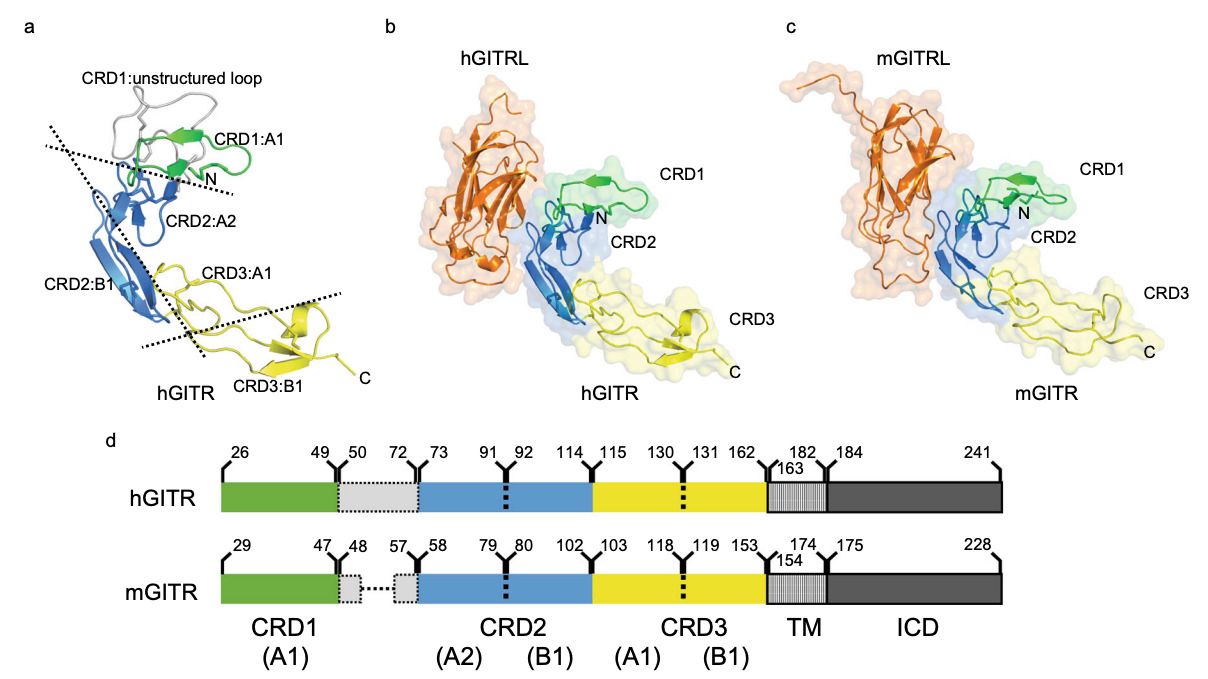Hi-Affi™ Humanized GITR Immune Checkpoint Knockin Mouse Model
Immune checkpoints have held the spotlight as an effective and promising strategy to stimulate anti-tumor T cell activity in the field of cancer therapies. GITR (glucocorticoid-induced tumor necrosis factor receptor) was recently identified as a novel member of the TNF receptor superfamily, which is a surface receptor molecule that involved in inhibiting the suppressive activity of T-regulatory cells and prolonging the survival of T-effector cells. It has been reported that the loss of GITR may be highly relevant to pathogenesis in differential human cancers. As a world leader in the industry of antibody and animal models, Creative Biolabs is now proud to provide you a set of well-characterized Hi-Affi™ humanized GITR knock-in mouse models for your research on potential tumor immunotherapy.
GITR Immune Checkpoint Pathway
Glucocorticoid-induced TNFR-related protein (GITR) or activation-inducible TNFR family receptor (AITR), which is also known as a member of the tumor necrosis factor receptor superfamily (member 18 as TNFRSF18), is currently of great interest to researchers focused on onco-immunology as a co-stimulatory immune checkpoint molecule. GITR has been proved to have increased expression upon T-cell activation, and it is supposed to play a crucial role in dominant immunological self-tolerance maintained by CD25+/CD4+ regulatory T cells. Studies in knockout mice also indicate that this receptor has an impact on the activation of CD3-driven T-cell and programmed cell death.
 Fig. 1 Modular representation of human and mouse GITR. 1
Fig. 1 Modular representation of human and mouse GITR. 1
On resting CD4+ and CD8+ T cells, GITR is expressed at a very low level while it is promoted upon stimulation. Nevertheless, GITR is constitutively expressed in T regulatory cells (T regs). And it is also exited on DCs, monocytes, and natural killer cells. The ligand of GITR is GITRL which is a type Ⅱ transmembrane protein, like most of the typical TNF ligand family members. GITRL is proved to be expressed at a high level on activated antigen presenting cells (APCs), endothelial cells, and activated T cell. Interactions between GITR on T cells and GITRL on APCs are bi-directional: both cell types are influenced by the interaction - eventually leading to T cell proliferation. The bond of GITR and GITRL triggers signaling that co-stimulating both CD4+ and CD8+ effector T cells, resulting in enhanced T cell expansion as well as effector function and simultaneously suppressing the activity of T reg cells. The co-stimulatory system of GITR induces the transition of anergic, hypoproliferative T cells to a hyperproliferative state. This may generate markedly enhanced T cell activation, resulting in a more efficient anti-tumor immune response. It is reported that ligation of GITR immune checkpoint molecule could regulate T regs, which induces a significant reduction in the accumulation of suppressive cells within the tumor microenvironment. Accordingly, this process eventually facilitates higher local effector T cell-T reg ratios, which bring out improved anti-tumor cytotoxic T cell function.
Development of Humanized GITR Immune Checkpoint Knock-In Mice
GITR is confirmed to be a vital stimulatory molecular engaged in the initiation and activation of effector T cell responses. According to the previous preclinical studies, it is certain that GITR & GITRL interactions positively regulating immunity by potentiating CD4+ and CD8+ effector T cell function while modulating regulatory T cells. This key process vulnerable to pharmacologic interventions which may augment the anti-tumor response. To modulate the GITR immune checkpoint pathway is regarded as a promising method of immunotherapy. With years of experience in animal models, Creative Biolabs has established a Hi-Affi™ platform, aiming at providing various types of human immune checkpoint KI mouse models for our worldwide clients. What's more, we also established comprehensive in vitro immunomodulation assessment service using various approaches. Please feel free to contact us for more details.
Creative Biolabs also offers other Humanized Mouse Models you may be interested in:
Reference
- Wang, Feng et al. "Structures of mouse and human GITR-GITRL complexes reveal unique TNF superfamily interactions." Nature communications vol. 12,1 1378. 2 Mar. 2021, doi:10.1038/s41467-021-21563-z. Distributed under Open Access license CC BY 4.0, without modification.
For Research Use Only.
